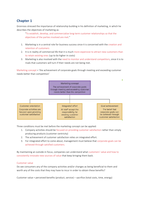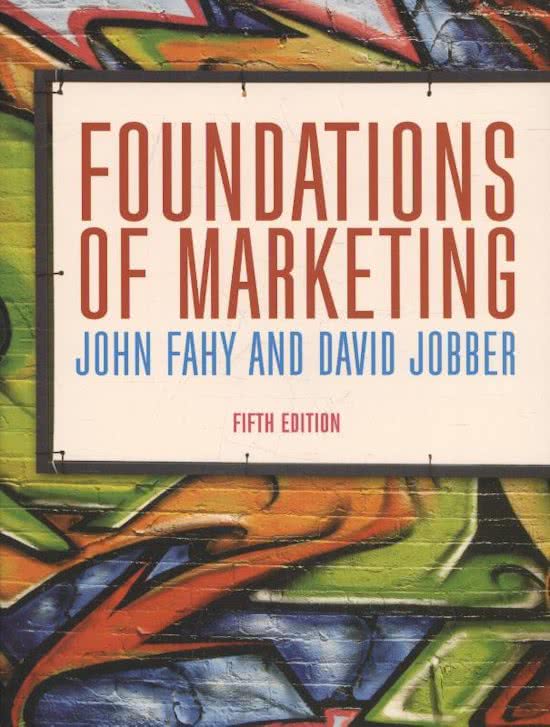Chapter 1
Gronroos stressed the importance of relationship building in his definition of marketing, in which he
describes the objectives of marketing as:
“To establish, develop, and commercialize long-term customer relationships so that the
objectives of the parties involved are met.”
1. Marketing is in a central role for business success since it is concerned with the creation and
retention of customers
2. It is in reality of commercial life that it is much more expensive to attract new customers than
to retain existing ones (up to 6x higher in costs)
3. Marketing is also involved with the need to monitor and understand competitors, since it is to
rivals that customers will turn if their needs are not being met.
Marketing concept = ‘the achievement of corporate goals through meeting and exceeding customer
needs better than competition’
Three conditions must be met before the marketing concept can be applied:
1. Company activities should be focused on providing customer satisfaction rather than simply
producing products (customer centricity)
2. The achievement of customer satisfaction relies on integrated effort.
3. For integrated effort to come about, management must believe that corporate goals can be
achieved through satisfied customers.
By maintaining an outside-in focus, companies can understand what customers’ value and how to
consistently innovate new sources of value that keep bringing them back.
Customer value
Do see consumers any of the company activities and/or changes as being beneficial to them and
worth any of the costs that they may have to incur in order to obtain these benefits?
Customer value = perceived benefits (product, service) – sacrifice (total costs, time, energy)
,Customer satisfaction depends on its perceived performance compared to the buyer’s expectations,
which are formed through pre-buying experiences, discussions with other people, and suppliers’
marketing activities.
Kano model of customer satisfaction
1. ‘Must be’ are expected and thus taken for granted
2. ‘More is better’ can take the satisfaction past neutral
3. ‘Delighters’ are unexpected characteristics that surprise the customers
Four forms of customer value:
1. Price value (perceived as being cheaper than those offered by
competitors. Often providing basic products at low prices)
2. Performance value (attracted to products by their functionality and perceived
quality levels. Value through functionality and performance
features)
3. Emotional value (Difference is in the mind of the consumer, like safety of Volvo
cars, and is created through marketing activities)
4. Relational value (quality of service received by the consumer)
Lifetime value of a customer = Recognition by the company of the potential sales,
profits, and endorsements that come from a repeat
customer who stays with the company.
Value is often co-created between organizations and customers.
,Customer value proposition or unique selling point (USP) is a reason why customers
return to them again and again.
It is not normally possible to compete on more than one dim ension as to do would mean
presenting a confusing message. However, the proposition may evolve over time.
M arketing definition = the delivery of value to customers at a profit
M arketing planning = the process by which businesses analyze the environment and their
capabilities, decide upon course of marketing action, and implement
those decision.
Business m ission = a broadly defined, enduring statement of purpose that distinguishes a
business form from others of its type.
Effective statements infuse organization with a sense of purpose as well as defining the
dom ains in which they operate. Refers to the ultimate goal of the company.
The vision is a coherent and powerful statement of what the business should aim to
becom e. Refers to the path the company takes to reach for the mission.
Whether an organization chooses to differentiate or to be a cost leader will have important
implications for the amount and type of marketing activity that takes place.
Marketing audit = an analysis of the organization’s current situation. The marketing audit is a
systematic examination of a firm’s marketing environment, objectives, strategies and activities, which
aims to identify key strategic issues, problem areas, and opportunities.
, Guideline SWOT:
1. Focus on relative rather than
absolute strengths and
weaknesses
2. Strengths need to be looked
at objectively as they can
sometimes turn into
weaknesses.
3. Only those strengths that are
valued by the customers
should be included.
4. Opportunities and threats
should be listed as anticipated
events or trends outside the
business that have
implications for performance.
M arketing objectives have
two types of objectives to be
considered:
• Strategic thrust
• Strategic objectives
The definition of marketing objectives may be derived from the results of the marketing audit and the
SWOT analysis. Two types of objective need to be considered: strategic thrust and strategic objectives.
Decisions regarding how the company chooses to grow are incorporated within its strategic thrust.
The core elements of marketing strategy involve decisions related to market segmentation, targeting
and positioning.
Any strategy will be ineffective unless it is converted into actions. This set of decisions has traditionally
been described as the company’s marketing mix, which normally comprises the 4Ps of product, price,
promotion and place:
• Product decisions refer to choices that are made regarding the products/services and benefits
that are going to be offered to a particular customer group.
• Price refers to all the decisions that are made regarding the different price points used for
products in the company’s range as well as all those decisions regarding the raising or
reducing of prices in response to competitor activity and consumer demand.
• Place refers to distribution activity, that is, the processes by which products and services are
delivered to customers.
• Decisions that are made regarding Facebook and Twitter campaigns, sponsorship, radio
advertising and so on all constitute elements of a promotional mix.







